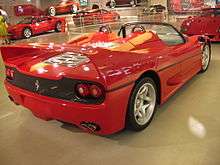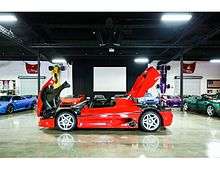Ferrari F50
The Ferrari F50 (Type F130) is a mid-engine sports car manufactured by Italian automobile manufacturer Ferrari from 1995–1997. Introduced in 1995, the car is a two-door, two seat targa top. The car is powered by a 4.7 L naturally aspirated Tipo F130B 60-valve V12 engine that was developed from the 3.5 L V12 used in the 1990 Ferrari 641 Formula One car. The car's design is an evolution of the 1989 Ferrari Mythos concept car.[7]
| Ferrari F50 | |
|---|---|
 | |
| Overview | |
| Manufacturer | Ferrari S.p.A |
| Production | 1995–1997[1] 349 produced |
| Assembly | Maranello, Italy |
| Designer | Lorenzo Ramaciotti[2] and Pietro Camardella[3] at Pininfarina |
| Body and chassis | |
| Class | Sports car (S) |
| Body style | 2-door Targa top |
| Layout | Rear mid-engine, rear-wheel-drive |
| Related | Ferrari F50 GT |
| Powertrain | |
| Engine | 4.7 L DOHC 65 degree Tipo F130B V12[4][5] |
| Power output | 382 kW (519 PS; 512 hp) |
| Transmission | 6-speed manual |
| Dimensions | |
| Wheelbase | 2,580 mm (101.6 in) |
| Length | 4,480 mm (176.4 in) |
| Width | 1,986 mm (78.2 in) |
| Height | 1,120 mm (44.1 in) |
| Curb weight | 3,080 lb (1,397 kg) [6] |
| Chronology | |
| Predecessor | Ferrari F40 |
| Successor | Enzo Ferrari |
Only a total of 349 cars were made with the last car rolling off the production line in July 1997.
The F50's engine predated the car; it was used in the Ferrari 333 SP for the American IMSA GT Championship in 1994, allowing it to become eligible for the stock engine World Sports Car category.
Racing
Following the motorsport theme of the Ferrari F40 LM, Ferrari developed the F50 based F50 GT in collaboration with its racing partners Dallara and Michelotto to compete in GT1-class racing. Notable changes made to the car include a fixed roof, a large rear spoiler, new front spoiler, adjustable suspension system, Speedline racing alloy wheels with racing slicks and a large rear diffuser. The 4.7-litre V12 engine in the F50 GT was tuned to generate a power output of around 551 kW (749 PS; 739 hp) at 10,500 rpm. A test held in 1996 proved the car to be quicker even than the 333SP, but this went unnoticed as Ferrari cancelled the F50 GT project due to entry of purpose built racing cars in competition such as the Porsche 911 GT1 and due to lack of funding, instead focusing on Formula One after the BPR Global GT Series folded. Ferrari sold off the three complete chassis that were built - the test car 001, 002 and 003. Chassis 002 and 003 had bodies fitted before being sold. The remaining three tubs were reportedly destroyed.[8][9]
Specifications

General
- Manufactured in: Maranello, Italy
- Number produced: 349 (1995 to July 1997)
- Inspiration: 1990 Ferrari 641 as driven by Alain Prost[10]
Dimensions

- Dry weight: 1,230 kg (2,712 lb)[11]
- Distribution: 42%/58 % (front/rear)
- Length: 4,480 mm (176.4 in)
- Height: 1,120 mm (44.1 in)
- Width: 1,986 mm (78.2 in)
- Wheelbase: 2,581 mm (101.6 in)
- Front track: 1,621 mm (63.8 in)
- Rear track: 1,603 mm (63.1 in)
Engine
.jpg)
- Type: Tipo 036-derived, model SFE 4.7 VJGAEA, Tipo F130 B
- Position: Rear mid-engine, rear-wheel-drive layout
- Configuration: Longitudinally-mounted 65° V12
- Aspiration: Naturally aspirated, with variable-length intake manifold via butterfly valve in intake manifold
- Intake manifold: carbon fibre reinforced polymer
- Block: Modular cast iron
- Heads/Pistons: light-alloy aluminum heads/forged Mahle pistons
- Oil sump: aluminium
- Connecting rods: forged titanium
- Crankshaft: forged steel
- Cam covers/Oil and water pump housing: magnesium sand castings
- Exhaust manifold: stainless steel
- Engine weight: 198 kg (437 lb)
- Valvetrain: 5 valves per cylinder (3 intake, 2 exhaust), 60-valves (total) DOHC per cylinder bank driven by low-noise Morse chain
- Displacement: 4,698.50 cc (4.7 L; 286.7 cu in)[11]
- Max. power: 382 kW (519 PS; 512 bhp) at 8,000 rpm
- Max. torque: 471 N⋅m (48 kg⋅m; 347 lb⋅ft) at 6,500 rpm
- Specific output.: 81.3 kW (110.5 PS; 109.0 bhp)/litre
- Weight/Power ratio: 2.69 kg/PS
- Bore X Stroke: 85 mm × 69 mm (3.35 in × 2.72 in)
- Bore:Stroke ratio: 1.23:1 (oversquare)
- Compression ratio: 11.3:1
- Redline: 8,500 rpm
- Fuel cutoff: 8,640 rpm[12]
- Fuel feed: Bosch Motronic 2.7 sequential injection and Electronic control unit (controls the fuel feed, ignition timing, and variable length intake and exhaust systems)
- Ignition system: Bosch static electronic distributor-less ignition
- Lubrication: dry sump, tank incorporated within the final drive housing, 3 scavenger pumps
- Variable intake: butterfly valve in carbon fibre intake manifold closed at low rpm, open at high rpm
- Variable exhaust: butterfly valve in upper tailpipes closed at low rpm, open at high rpm
- Fuel tank: foam filled, aeronautical-style Sekur rubber bladder, 105 L (28 US gal; 23 imp gal)
Fuel consumption
Transmission
- Configuration: longitudinal 6 speed manual + reverse, limited slip differential, RWD
- Gear ratios: 2.933:1 (1st), 2.157:1 (2nd), 1.681:1 (3rd), 1.360:1 (4th), 1.107:1 (5th), 0.903:1 (6th), 2.529:1 (reverse)
- Final drive: 3.70:1
- Flywheel: steel
- Final Drive Assembly: aluminum sand casting
- Remaining gearset housing: magnesium sand casting
- Support bracing: steel
- Flywheel: steel
- Clutch: dry, twin plate
- Cooling: oil-water intercooler between gearbox lubricant and engine
Chassis
- Type: central carbon fiber tub, light-alloy suspension and engine-gearbox assembly mounting points co-polymerised to the chassis
- Materials: carbon fiber, epoxy resin, Nomex honeycomb structure core, sandwich construction
- Torsional stiffness: 34,570 N⋅m (25,500 lb⋅ft) per degree
Suspension
- Front: Rose-jointed unequal-length wishbones, push-rods, coil springs, Bilstein gas-pressurised monotube dampers, electronic adaptive damping, electronic height adjustment (40 mm max)
- Rear: Rose-jointed unequal-length wishbones, push-rods, coil springs, Bilstein gas-pressurised monotube dampers, electronic adaptive damping, mounting points on a spacer between the engine and gearbox
- Travel: 55 mm bump, 60 mm rebound
- Camber angle: -0.7 degrees front, -1.0 degrees rear
- Anti-roll bars: front and rear
- Max. roll angle: 1.5 degrees
Steering
- Type: TRW rack and pinion, 3.3 turns lock to lock, unassisted
- Caster angle: 5.5 to 5.7 degrees
- Turning circle: 41 ft (12 m)
Miscellaneous
- Electronic adaptive damping (based on steering wheel angle and velocity, the body's vertical and longitudinal acceleration, brake line pressure, and vehicle speed)
- Maximum reaction time (from minimum to maximum damping force or vice versa): 140 milliseconds (0.14 s)
- Average reaction time (from minimum to maximum damping force or vice versa): 25 to 30 milliseconds (.025 to .03 s)
Wheels/tires/brakes
.jpg)
- Wheels: magnesium alloy, manufactured by Speedline
- Hubs: titanium
- Brake disc bells/suspension uprights/brake calipers: aluminum
- Upper and lower wishbones: black powder-coated steel
- Front wheels: x
- Front tires: 245/35ZR-18 Goodyear Eagle F1 GS Fiorano (35psi)
- Front brakes: Brembo cross-drilled & ventilated cast iron discs, 4 piston aluminum Brembo calipers, Pagid brake pads, (without ABS)
- Rear wheels: x
- Rear tires: 335/30ZR-18 Goodyear Eagle F1 GS Fiorano (30psi)
- Rear brakes: Brembo cross-drilled & ventilated cast iron discs, 4 piston aluminum Brembo calipers, Pagid brake pads, (without ABS)
- Unsprung mass: 99 lb/121 lb (front corners/rear corners)
Colour popularity
- Rosso Corsa (Red): 302
- Giallo Modena (Yellow): 31
- Rosso Barchetta (Dark red): 8
- Argento Nurburgring (Silver): 4
- Nero Daytona (Black): 4
Performance
.jpg)
Automotive magazine Car and Driver tested an F50 in 1997 and published the following results:
- 0-48 km/h (30 mph): 1.7 seconds[14]
- 0-64 km/h (40 mph): 2.4 seconds[14]
- 0-80 km/h (50 mph): 3.0 seconds[14]
- 0–97 km/h (60 mph): 3.8 seconds[15]
- 0–110 km/h (70 mph): 4.7 seconds[14]
- 0–130 km/h (80 mph): 5.5 seconds[14]
- 0–140 km/h (90 mph): 7.5 seconds[14]
- 0–160 km/h (100 mph): 8.5 seconds[15]
- 0–180 km/h (110 mph): 10.1 seconds[14]
- 0–190 km/h (120 mph): 11.6 seconds[14]
- 0–210 km/h (130 mph): 13.4 seconds[14]
- 0–230 km/h (140 mph): 15.9 seconds[14]
- 0–240 km/h (150 mph): 18.8 seconds[14]
- 0–260 km/h (160 mph): 21.8 seconds[14]
- 0–270 km/h (170 mph): 26.8 seconds[14]
- 1/4 mile: 12.1 seconds at 198 km/h (123 mph)[15]
- Skidpad: 0.95g[15]
- Braking 70–0 mph (113–0 km/h): 176 ft (54 m)[15]
- Top speed: 312 km/h (194 mph)[15] (325 km/h (202 mph) claimed)[11]
Track Tests
The F50 had the following track times:
- Tsukuba Circuit: 1:05.81[16]
- Suzuka Circuit (2000): 2:25.525[17]
- Sugo: 1:38.573[18]
- In 2016, an F50 joined Top Gear's Nürburgring Nordschleife challenge in Germany. It completed the track in 7:47, 3 seconds faster than the Dodge Challenger SRT Hellcat but 28 seconds slower than the Mercedes-AMG GT R.[19]
Other media
The F50 is featured on the cover and in the racing video game Need For Speed II.
References
| Wikimedia Commons has media related to Ferrari F50. |
- "Ferrari to show Enzo replacement to a select few by the end of the year". Autoweek.
- "Ferrari F50, the background". howstuffworks. Retrieved 2017-12-14.
- "Rencontre avec Pietro Camardella & Gino Finizio" (in French). July 2006. Archived from the original on 26 September 2006. Retrieved 5 March 2008.
- Derrick, Martin; Clay, Simon (2013). Million Dollar Classics: The World's Most Expensive Cars. Chartwell Books. ISBN 978 0 7858 3051 1.
- "Ferrari F50 engine details". Ferraris-online.com. Retrieved 2017-12-14.
- Phillips, John (January 1997). "Ferrari F50 Road Test Car and Driver" (PDF).
- Jay Traugot (2013-05-11). "Ferrari F50, an evolution of the Mythos". carbuzz. Retrieved 2017-12-15.
- Ballaban, Michael (2016-12-30). "All Hail The Odd Ball Ferrari F50 GT". Jalopnik. Retrieved 2019-01-21.
- "1996 Ferrari F50 GT: One of three". Classic Driver. 2012-12-08. Retrieved 2019-01-21.
- "Car Collection Gallery at The Marconi - Orange County Venue". Retrieved 29 December 2016.
- "Ferrari F50 (1995) - Ferrari.com". Ferrari GT - en-EN.
- Ferrari F50 - Car and Driver (PDF)
- "fueleconomy.gov". Retrieved 11 February 2016.
- "C/D Test Results" (PDF).
- John Phillips (January 1997). "Ferrari F50 — Why it took 13 months to get our hands on this supercar". Car and Driver. Retrieved 2012-01-14.
- "Best Motoring - Platinum Series Vol. 12".
- "Best Motoring 2000 Suzuka Super Battle".
- "Best Motoring Super Car Race f50, 911 Gemballa, GT2, Murcielago, NSX R".
- "Glory Of The Legends". Top Gear. Retrieved 2016-10-08.
Bibliography
- Buckley, Martin; Rees, Chris (1998). World Encyclopedia of Cars. London: Anness Publishing. ISBN 1-84038-083-7.